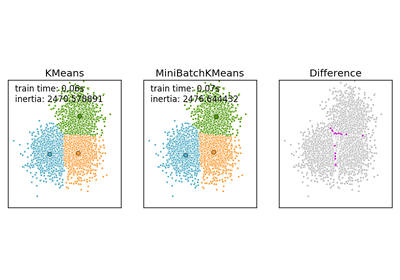sklearn.metrics.pairwise_distances_argmin¶
-
sklearn.metrics.pairwise_distances_argmin(X, Y, axis=1, metric='euclidean', batch_size=500, metric_kwargs=None)[source]¶ Compute minimum distances between one point and a set of points.
This function computes for each row in X, the index of the row of Y which is closest (according to the specified distance).
This is mostly equivalent to calling:
pairwise_distances(X, Y=Y, metric=metric).argmin(axis=axis)but uses much less memory, and is faster for large arrays.
This function works with dense 2D arrays only.
Parameters: X : array-like
Arrays containing points. Respective shapes (n_samples1, n_features) and (n_samples2, n_features)
Y : array-like
Arrays containing points. Respective shapes (n_samples1, n_features) and (n_samples2, n_features)
batch_size : integer
To reduce memory consumption over the naive solution, data are processed in batches, comprising batch_size rows of X and batch_size rows of Y. The default value is quite conservative, but can be changed for fine-tuning. The larger the number, the larger the memory usage.
metric : string or callable
metric to use for distance computation. Any metric from scikit-learn or scipy.spatial.distance can be used.
If metric is a callable function, it is called on each pair of instances (rows) and the resulting value recorded. The callable should take two arrays as input and return one value indicating the distance between them. This works for Scipy’s metrics, but is less efficient than passing the metric name as a string.
Distance matrices are not supported.
Valid values for metric are:
- from scikit-learn: [‘cityblock’, ‘cosine’, ‘euclidean’, ‘l1’, ‘l2’, ‘manhattan’]
- from scipy.spatial.distance: [‘braycurtis’, ‘canberra’, ‘chebyshev’, ‘correlation’, ‘dice’, ‘hamming’, ‘jaccard’, ‘kulsinski’, ‘mahalanobis’, ‘matching’, ‘minkowski’, ‘rogerstanimoto’, ‘russellrao’, ‘seuclidean’, ‘sokalmichener’, ‘sokalsneath’, ‘sqeuclidean’, ‘yule’]
See the documentation for scipy.spatial.distance for details on these metrics.
metric_kwargs : dict
keyword arguments to pass to specified metric function.
axis : int, optional, default 1
Axis along which the argmin and distances are to be computed.
Returns: argmin : numpy.ndarray
Y[argmin[i], :] is the row in Y that is closest to X[i, :].



